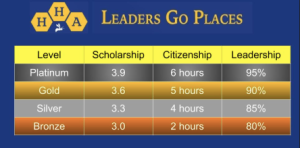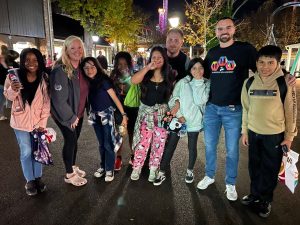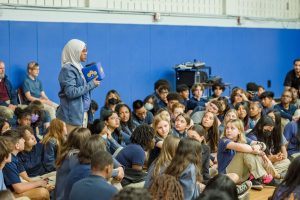 Twelve years ago, a group of us at Hampstead Hill Academy, a Baltimore Curriculum Project (BCP) neighborhood conversion public charter school in South Baltimore, launched Leaders Go Places (LGP) with our middle school. The initial idea and early funding for the incentive-based program to encourage and empower 6th through 8th graders to focus on academics, personal development, and positive peer interactions originally came from The Living Classrooms Foundation.
Twelve years ago, a group of us at Hampstead Hill Academy, a Baltimore Curriculum Project (BCP) neighborhood conversion public charter school in South Baltimore, launched Leaders Go Places (LGP) with our middle school. The initial idea and early funding for the incentive-based program to encourage and empower 6th through 8th graders to focus on academics, personal development, and positive peer interactions originally came from The Living Classrooms Foundation.
A key component of each LGP gathering – circles, recognition ceremonies, and field trips – is the recitation of “My Five Promises,” which we based on similar objectives at The Living Classrooms. LGP’s five promises are:
- I will contribute to the common good.
- I will persevere.
- I will produce quality work.
- I will conduct myself with honor and integrity.
- I will advocate for myself and others.
I’ve helped lead LGP since the beginning, in addition to my full-time job as HHA’s middle school academic coach. Prior, I taught middle school science at HHA for eight years before transitioning into the coach role.
Empowering Middle School Students Through Leaders Go Places
Our middle school incentive program, LGP, teaches students how to lead. We acknowledge and reward students for scholarship (grade point average or GPA, a new concept for middle schoolers), leadership (good behavior and attendance), and citizenship (community service).
 These leadership qualities are critical for student development and the high school admissions process. We believe that every HHA middle school student has the potential to achieve a leadership level every quarter (or roughly every 45 school days). To be “on level”, students must meet all three criteria in scholarship, citizenship, and leadership for that level:
These leadership qualities are critical for student development and the high school admissions process. We believe that every HHA middle school student has the potential to achieve a leadership level every quarter (or roughly every 45 school days). To be “on level”, students must meet all three criteria in scholarship, citizenship, and leadership for that level:
Students also receive one merit for daily on-time attendance and one merit for displaying positive behaviors, like the Five Promises. If a student is tardy or has an unexcused absence, they lose one merit. Any negative behavior (conferences, restorative room referrals, detentions, or suspensions, also mean demerits.
We break down LGP data each quarter by race, gender, homerooms, and special services to analyze our results. Communication is vital to the program’s success. We communicate positive and negative student behaviors with teachers and families through our ClassDojo app. Teachers share LGP Progress Reports with students half way through each quarter during a scheduled advisory period.
Creating Incentives for Adolescent Positive Behaviors and Goal-Setting
We sponsor an LGP recognition ceremony each quarter for students and parents to acknowledge and celebrate their progress in the program. Of course, with middle schoolers, it’s all about the swag. Depending on the level and previous recognition, students receive special LGP-branded polo shirts and fleece jackets, which they may wear as their HHA uniform, fun and practical items, and certificates. Each 6th grader gets an “H” varsity letter on which they pin their LGP pins that designates the levels. Students collect pins to track their levels.

We also encourage exploration of college and career opportunities with a variety of guest speakers who talk about college and career readiness using one of LGP’s five promises as a guiding theme. We’ve had University of Baltimore president and former Baltimore Mayor Kurt Schmoke, Maryland Attorney General Anthony Brown, a Southwest pilot, City Council President Zeke Cohen, BCPSS CEO Santelises, and our parents. Joy Davis, Visual Arts Director of the Creative Alliance spoke to us about her work, which we connected to indigenous art for Native American Heritage Month.
We build a network of these community leaders who return for our career fair, as judges for our National History Day Fair in January, and more. I want our LGP students to build relationships with these leaders.
What I’ve come to appreciate most about LGP is the impact that it’s having on kids. Each spring, our Principal Matt Hornbeck conducts exit interviews with our 8th graders. A huge proportion of the students mention LGP as their favorite thing. They remember the conversations or a guest speaker that we had in a circle or a field trip. When I think back on my schooling, it wasn’t the classes that I remember. It was the field trips, extracurricular clubs, and the relationships I had with teachers. LGP does a good job of creating those experiences for kids.
Introducing High School GPA and Service Learning Through LGP
We built LGP from what we saw our HHA alumni experiencing with their high school transition. Our students weren’t learning about what a GPA is and how important it is until high school, usually after freshman year first quarter, when their GPA is a 2.0 and they realize improving a GPA is hard when you take a big hit in your first year of high school.
We made GPA as a metric of our program. We created a tool for middle school students to calculate their GPA and reward them for different levels of GPA. When they get to high school—HHA students often are accepted to Baltimore’s top public high schools and to private schools across the region—our students understand GPAs and have both context and experience with what it takes for consistent, high-level academic success.
In Baltimore City Public Schools, BCP’s partner, students are required to earn 75 hours of service learning to graduate from high school. We saw that prior to service learning being a pillar of LGP, students were entering high school without knowing what service learning was. Often, students would wait until junior or senior year to accrue the required hours, just when they should be focusing on college applications.
We’ve built service hours into LGP, which count towards the 75 hours. About 90% of our eighth graders leave HHA with all 75 hours completed. This means it’s not a distraction in high school. LGP service learning includes writing notes and making Happy Mats (placemats with games) for the Cool Kids Foundation that supports kids in long-term hospital care. LGP students volunteer as tutors in our school and help with our sports programs. We encourage them to volunteer in their community and with clean-ups at Patterson Park.
Creating Real-Time Impact and Big Outcomes for Students and the School
LGP is the premier implementation of Restorative Practices at our school. With Restorative Practices, there’s the reactive side of it, which is conflict resolution and behavior management. Then there’s the proactive piece with relationship building. Having opportunities to talk to kids about things besides math and science and coming together as the entire middle school every Friday morning in a circle is extremely proactive.
During our Friday circles, students will make public shout-outs and apologies. We’ll talk about the Five Promises and participate in mini-lessons about topical events, monthly heritage celebrations, and real-life examples of our Five Promises. It’s all about creating a community and safe place for middle schoolers to be their authentic selves.

Over the last 12 years, we’ve seen significant drops in some of the quantitative measures of school culture. Suspensions and detentions have gone down significantly. When we look at school surveys from parents and students, things like feeling safe and happy at school or wanting to come to school have gone up significantly. HHA has one of the strongest attendance rates in the district partly because kids want to come to school and because of the community that we build with LGP.
We’ve seen a culture shift and stronger relationships. We have less distracting, typically middle school behaviors that you might otherwise see that are taking away from learning. HHA’s scores are some of the highest in Baltimore and Maryland because our kids can focus on learning when everything else is taken care of. That’s the real-time impact.
The broader picture, the outcomes of the program, are that LGP students fare well in the high school choice process and in high school. Every October, we bring our alumni back for an alumni reunion and to talk to the current 8th grade about high school and college. We also have alumni do a survey to gather more data on the value of the program.
Teaching Resilience Through Leaders Go Places
We’ve learned a lot about what carries with them into high school and beyond. Alumni feel empowered because they know about the importance of the high school GPA, service learning hours, and reinforce that with our 8th grade.
More, qualitatively, the Five Promises of our program are examples alumni point to, particularly the value of persevering. Alumni talk about ways that they have persevered in high school. They may or may not have done that without LGP, but their ability to articulate it and to reflect on it is certainly unique because we talk about those things constantly in the program.
 Isolationism with young people was occurring before the pandemic, but we hear about it a lot more now. Our 6th graders were 1st graders in 2020, and were isolated and in remote learning on a screen when they were learning to read, to make important social connections. Many middle schoolers today have not been able to build authentic social relationships because they’re used to being behind the screen.
Isolationism with young people was occurring before the pandemic, but we hear about it a lot more now. Our 6th graders were 1st graders in 2020, and were isolated and in remote learning on a screen when they were learning to read, to make important social connections. Many middle schoolers today have not been able to build authentic social relationships because they’re used to being behind the screen.
There are gaps in their development that certainly contribute to some negative behaviors. LGP allows us to be intentional about creating spaces that break down those walls for kids to see each other and be with each other in unique ways that’s not just in the classroom. A big component of our Community Circles is when students acknowledge and apologize to each other. When guests come and visit the circles, they’re always amazed with the level of sincerity and specificity and the bravery that it takes for kids to stand up in front of 300 of their peers to speak into a microphone and to share acknowledgments or apologies. That type of social intelligence is something that if kids this age don’t develop, they have a hard time with what society is going to demand of them in high school and beyond. I believe that LGP enables our kids to end up better adjusted and positioned to face challenges in a more productive way.
Addressing Mental Illness Challenges with Adolescents Today
Our program has adapted as the mental illness crisis with adolescents and teenagers has grown over the past decade. We have much more candid conversations about mental health and suicide prevention and awareness than we ever have before. We have those conversations in our circles and lessons and in one-on-one discussions with students.
With the spaces we’ve created, we’ve been able to bring in mental health practitioners and outside resources to talk to kids. Our lessons are often topical and related to real-world events that can be causing kids stress.
We talk a lot about social media and how to keep themselves safe. HHA is a cell-phone free school. Every student puts their cell phone in a locked Yondr bag each morning. When we were making that decision, we had conversations about it with LGP, and our students were not really adverse to putting their cell phones away during the school day because we had spent so much time in our community circles talking about the mental health impact on them from social media. We give them resources and space to process those things.
Inspiring Leaders Getting Ready to Prepare 5th Grade for Success
Three years ago, we added a program for our 5th grade, Leaders Getting Ready. We realized that our rising 6th graders could use a little bit more structure before getting into the significant amount of structure in LGP. There’s a lot going on with transition to middle school with puberty, goal-setting, friendship, and relationship building, yet we don’t really consider 5th graders middle schoolers.
Leaders Getting Ready is an LGP “lite” program. We don’t have students complete service learning, and GPA is not talked about in the same way. Behavior expectations are different, too. We do circles twice a quarter, but they still do acknowledgments and apologies. Since this program was started by Assistant Principal Mike Lucas, I have seen an improvement in the quality of what kids are sharing in LGP circles with a bit more experience.
It really takes a village. Our teachers buy into it and carry out the logistics. Our parents reinforce it, and of course, our Principal and administration make it happen budget-wise. We’ve done a good job of building the mindset around LGP that has not only kept it going for 12 years, but keeps it evolving.
If you are interested in learning more about our LGP program, please reach out to the Director, Matt Cobb at mcobb@hha47.org.
